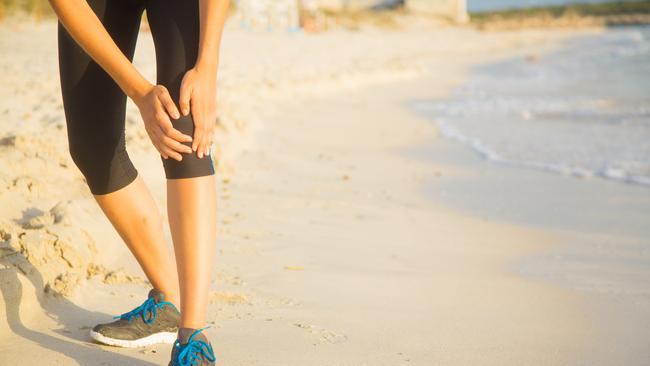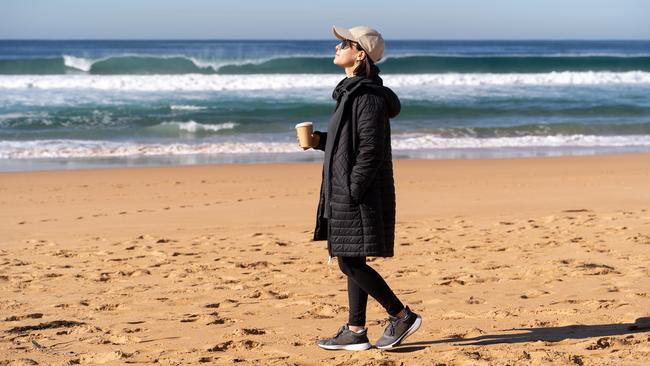A top trainer’s tips to protect your knees
Tips and exercises to strengthen and prevent pain from midlife onwards.

One in five adults aged over 45 suffers from painful knees, according to the charity Versus Arthritis, but while aching and stiffness are common, they are by no means inevitable.
Dalton Wong, the top trainer and founder of TwentyTwo Training, explains that much of the pain can be prevented with the correct exercise, and he has seen a rise in the number of clients seeking help to do just this.
“In our 20s and 30s we think about improving strength and endurance,” Wong says. “But very few people think about protecting their knees until they get the first niggles or pain.” The sooner we start to pay them attention the better, he points out.
According to VA, our knees are among the most common sites for osteoarthritis. Often a result of wear and tear, the condition is thought to be responsible for the knee pain of 5.4 million people in the UK. It occurs when the smooth, slippery cartilage at the ends of the thigh and shin bones and around the kneecap thins, causing joint surfaces to become rough and the knee to move less smoothly than it did. This can be caused by age, but it may also be the legacy of sporting injuries, particularly those activities that involve a lot of twisting and turning such as football, skiing and tennis.
Neglect of vital muscles also plays a part. Wong says failure to work the teardrop-shaped VMO (vastus medialis oblique) muscle that stabilises the kneecap can lead to a lack of support for the joint in midlife. “The VMO is a knee extensor muscle used in every functional movement, from squatting to walking,” he says. “If we don’t use it, particularly from midlife onwards, it becomes weak and more prone to twisting and strains, yet there are lots of ways to strengthen this muscle.”
Moving knees as much as possible is essential for supplying protective nutrients to the area and for keeping them working well. Yet a recent study in the Pain journal found that although physical activity has been proved to relieve stiff, aching joints, only one in 10 sufferers exercises regularly, and many others mistakenly believe exercise is harmful for their painful knees.
“The best thing you can do for your knees is to keep moving them in different ways,” Wong says. Here’s how:
1. Walk at least 6000 steps a day
Midlifers diagnosed with early signs of knee osteoarthritis were 40 per cent less likely to experience new knee pain if they walked regularly compared with non-walkers, according to a study by researchers at Baylor College of Medicine in Houston, Texas.
Grace Hsiao-Wei Lo, assistant professor of immunology, allergy and rheumatology and a lead author of the study, says daily walking for exercise not only seems to prevent the onset of frequent knee pain but might slow down the worsening of damage inside the joint.

“People diagnosed with knee osteoarthritis should walk for exercise, particularly if they do not [yet] have daily knee pain,” she says. A minimum of 6000 steps a day should be the target; a report in the Arthritis Care & Research journal showed this amount of steps could protect those at risk of knee problems from the kind of sharp decline that results in mobility issues in older age, such as difficulty climbing stairs.
2 Do glute bridge and clam exercises every other day
Along with deadlifts, these are what Wong refers to as “foundation” exercises for knee health. “They strengthen the quadriceps, hamstrings and glutes that work together to support the joint,” he says.
Raising your heels on to a book or yoga block when performing squats also helps to protect the knees and target the VMO, Wong says.
“It’s a simple but very effective trick I use with clients as it takes work away from the calf muscle and recruits the quads instead,” he says. “It also makes it easier to achieve a good range of motion with stiffer knees.”
3. If you don’t already lift weights, start now
It might sound counterintuitive that loading the joints with weight training can also protect them. Yet researchers reporting on findings from 2607 people for a study in Arthritis & Rheumatology last year confirmed “strength training is associated with better knee health”, and the earlier in your 20s, 30s and 40s you adopt it the better. People who did some form of strength training regularly were 23 per cent less likely to develop knee arthritis than those who did none. “Start by lifting your own body weight before adding weights,” Wong says. “Resistance work has benefits for joints, bones and muscles so will help the knees.”
4. Go swimming as often as you can
Swimming is known to be kind to the joints, with the water acting as a giant cushion providing support. A review involving 2637 people in their 50s and 60s, published in the scientific journal of the American Academy of Physical Medicine and Rehabilitation, found “swimming is potentially beneficial towards knee health”, with swimmers up to 37 per cent less likely to experience pain in middle age. “Swimming is great for improving muscle strength without weight bearing,” Wong says. “It also helps to maintain a healthy range of motion of the knees.”

5. Try doing wall sits
Sustained contractions of the quadriceps muscles build strength and are great for building knee protection. “Isometric wall sits are a good example,” Wong says. Stand with your back against a wall and feet shoulder width apart. Slowly slide your back down the wall, inching your feet forwards, until your thighs are parallel to the ground or at an angle that feels comfortable to hold. “It’s better to start in a moderate position than to struggle,” Wong says. Make sure the knees are directly above the ankles and keep your back flat on the wall.
A study Australia and New Zealand researchers suggests the amount of time you hold the position is important because it allows for greater build-up of oxygen in the muscle. Holding for as long as you can, up to 30 seconds, is more beneficial than performing 10 holds for three seconds each with rests in between.
6. Use the leg-press machine at the gym
Wong believes anyone wanting to strengthen the muscles that support the knee should use the leg-press machine.
One way to target the VMO muscle is with squats, but as we get older most of us don’t achieve full range due to sore knees and a lack of hip mobility. This is where the leg-press machine comes in. “If you position your feet a bit lower than average on the plate and push from the balls of the feet, you really target the VMO,” Wong says. “Get your bottom really close to the plate before you drive with your legs and you ensure you reach the end range of movement as you would in a deep squat.” Try three sets of 8-10 repetitions.
7. Stand on one leg while brushing your teeth
Balance is a too often neglected element of knee health. “Our ability to balance declines as we age and the less stable we are, the more prone our knees are to strain and injury,” Wong says. “Something as simple as standing on one leg while brushing your teeth or waiting for the kettle to boil will do the trick.”
Many of us will remember this as one of Dr Michael Mosley’s key recommendations for improving health in later life. Progress to doing this on a cushion, which adds an element of instability.
THE TIMES





To join the conversation, please log in. Don't have an account? Register
Join the conversation, you are commenting as Logout